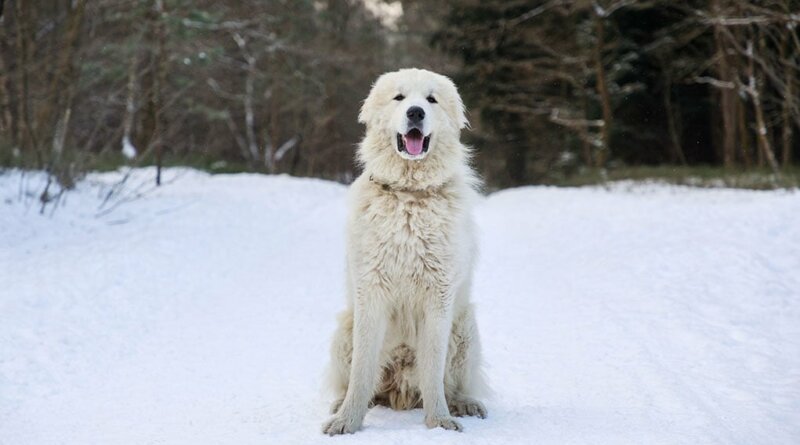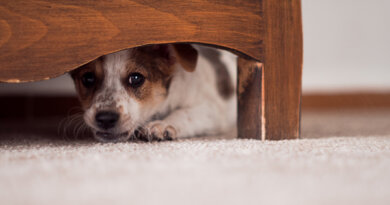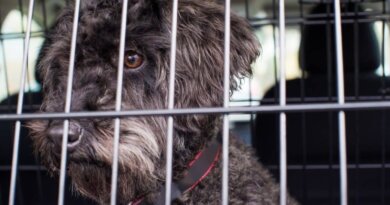Great Pyrenees Dog Breed Profile – Top Dog Tips
Large, powerful, and hard working. These are just a few characteristics to best describe the Great Pyrenees dog breed.
These dogs can easily be recognized because of their long, glowing white coats and calm mood.
The Great Pyrenees are incredibly strong dogs that were bred to protect livestock and more.
But even if they were made to guard and protect, these dogs are very affectionate to their families.
To this day, Pyrs are still vigilant guardians of their respective families and homes. They are often described as majestic as they are large and extremely strong mountain dogs.
The Great Pyrenees is not just a pretty face. They are also smart and serious, and they enjoy lots of time with their family.
If you’re planning to adopt a Great Pyrenees puppy, you better scroll down!
Below, we’ll discuss everything you’ll need to know about this dog breed. Starting from his history and down to his grooming needs.
Now without further ado, let’s start things off with the Great Pyrenees’ background.
Great Pyrenees History
Did you know that the Great Pyrenees breed is so old that they’ve been fossilized?
It is said that Pyrs most likely arrived in the Pyrenean Mountains around 3,000 B.C.
Their fossils were found in the region and dated to between 1800 B.C. and 1000 B.C. Experts believe that the dog breed evolved from white mountain dogs that originated in Asia Minor way back 11,000 years ago.
The Great Pyrenees breed was named after the Pyrenees Mountains. In these mountainous regions between Spain and France, they guarded sheep, goats, livestock, farmers, grass, flowers, and more.
But they are known by many names. They are known as Great Pyrenees in the United States and Canada.
They are also known as Pyrenean Mountain Dog in the United Kingdom and most of Europe.
Way back hundreds of years ago, the Great Pyrenees was considered to be dogs owned by peasants.
In 1675, however, the Dauphin in the court of King Louis XIV proclaimed that the dog breed was the Royal Dog of France.
During the 1800s, the breed grew in popularity throughout England, Europe, and the United States.
They were first introduced into the St. Bernard’s breeding program in Switzerland to help establish the number of dogs at the famous land where the St. Bernard dog breed originated.
Moreover, the American Kennel Club officially recognized the Great Pyrenees breed in 1933.
Great Pyrenees Physical Traits
The Great Pyrenees have excellent physical traits. For instance, they are mostly known for their solid white coat color.
This dog breed has a double coat. A top coat and an undercoat.
The top coat is long, thick, and coarse in texture. It can be straight or a little wavy, but keep in mind that it should not be curly.
Male Great Pyrenees also have a more noticeable mane around their necks. They also have feathering on the back of their legs.
Their tail, on the other hand, should have a plume, and their face and ears have short hair.
Their undercoat can be either shaded or white.
Pyrs’ coats are full white or white with markings. The color of the markings can range from badger, tan, gray, or reddish-brown. Also, these markings can be seen on the head, ears, tail, and body.
However, the markings should never cover more than one-third of the body.
A male Great Pyrenees stands 27–32 inches tall, weighing at least 100 to 160 pounds. Female Pyrs stand at 25 inches to 29 inches and weigh an average of 85 to 115 pounds.
These dogs are not only large, but they also have giant hearts! Now, let’s get right into their personalities.
The Temperament of the Great Pyrenees
The Great Pyrenees are calm and gentle. Being shy, aggressive, and nervous is a big no-no to this dog breed.
Pyrs are also somewhat serious. But his courage and loyalty make him a great family member. He is devoted to his people, protecting his family or any of his loved ones if needed.
The Great Pyrenees is also a very intelligent dog. They are used to working alone and figuring things out by themselves.
But if you’re looking for a guard dog, you can’t go wrong with adopting a Great Pyrenees. They are not only excellent guard dogs, but they are also friendly, calm, and gentle.
It’s the perfect dog for people who wants to live their lives peacefully.
Living with a Great Pyrenees
With early and proper socialization, Great Pyrenees can be a wonderful addition to the family. If you’re yearning for the suburban and placid lifestyle, this is the dog for you.
Pyrs can do okay in apartments since they are calm and mellow dogs.
But it is still best advised for them to live in homes with large spaces or yards where they can roam around freely. After all, they are mountain dogs.
Ensure that your yard is fully fenced-in, and it would be better if the fence is at least six feet or higher. These dogs are known to be escape artists.
There’s a reason why Great Pyrenees rescue groups won’t let anyone adopt a Pyr if their home doesn’t have a secured fence.
These dogs are great companions for having quiet time. And they also love children.
Pyrs will protect children with his own life. These dogs are big softies as they are much more tender and careful towards small children or any other weak creatures.
However, as parents of both children and pets, we must ensure that we supervise all of their interactions.
You should also train your child how to play and approach your dog to avoid unwanted biting, ear-pulling, tail-pulling, or any harm between both parties.
You should never leave them unsupervised.
Also, Great Pyrenees do well with other pets in the house, especially if they were raised together.
Socialization can come a long way for any dog breed. Pyrs can get along just fine with other dogs if trained correctly.
Training and Exercise
As we’ve discussed above, Pyrs are independent thinkers, making them a bit stubborn. That’s why it’s important to start his training at an early age.
It is best advised to start their training from the time he’s just a small puppy. They respond well to gentle and positive reinforcement training.
You’ll also need a lot of patience when training a Pyr. These dogs can easily get bored. Provide good and proper physical and mental stimulation to avoid destructive behaviors.
Kindness, consistency, and starting early are key to training a Great Pyrenees. Be consistent about your established rules around the house.
These dogs have excellent memory, and they can remember both good and bad associations. That’s why it’s important to keep their training calm and stress-free.
Just like any other dog breed, socialization is a crucial part of training. Pyrs were bred to be guard dogs.
If he’s not properly socialized, they can become aggressive or fearful, especially of strangers.
Compared to other large dog breeds, their exercise needs are average. When it comes to exercise, Pyrs need about 20 to 30 minutes of exercise per day to maintain his health.
They are fond of cool weather, and they love to go on long hikes. These strong and large dogs can even carry backpacks and gear. But remember to avoid hiking during hot weather.
Health Care of Great Pyrenes
Great Pyrenees is generally a healthy dog. Their life expectancy is about 10 to 12 years!
Unfortunately, similarly to any dog breed, they are prone to certain health conditions that you’ll need to look out for.
Hip Dysplasia
Hip Dysplasia is a genetic condition wherein the socket of the joint and ball becomes distorted.
If your Pyr gets diagnosed with hip dysplasia, it’s crucial to keep their weight within the normal range and have them exercise with activities that promote joint therapy.
Your vet can prescribe medications for anti-inflammatory, pain relievers, and supplements for this illness.
If you want to prevent this condition, keep them active but not to the point that they might injure themselves.
A treadmill walk or swimming is perfect for prevention and recovery as well.
Elbow Dysplasia
Similar to hip dysplasia, elbow dysplasia is a hereditary condition common to large dog breeds.
One possible cause of this condition is the different growth traits of the three bones that make up their elbow.
Dogs suffering from elbow dysplasia will suffer from painful lameness.
Your vet can recommend surgery to treat and correct the problem and will advise your pup to take medication to control the pain.
Patellar Luxation
Patellar Luxation happens when the patella moves its alignment out of the femur. Similar to the conditions above. Just like the ones above, patellar luxation is a hereditary disorder in dogs.
This can range from high to low levels of luxation, and each requires different cures.
Signs may include skipping and kicking off the leg. It’s best to consult with the vet for treatments, therapies, or procedures required to help a Samoyed with this condition.
If your Pyr has been diagnosed with patellar luxation, it should not be bred anymore. It’s best not to bring these despairing conditions to their descendants.
Cataracts
Cataracts are an obstruction of lens fiber in the lens of an eye. The gradual clouding of the lens in the eyes can lead to blindness.
Although this is more common in elderly dogs, it can also be acquired through genetics, traumatic injuries in the eyes, nutritional deficiencies, or diabetes.
Have your pet get an ophthalmic examination to detect small cataracts as early as they step four to five years old.
To determine whether it is blinding or not, check with your veterinarian to be informed what process or treatment should be done.
Entropion
Entropion is an eye problem in which the eyelid rolls inward, creating friction in the sensitive part of the cornea.
Usually, this condition needs surgery when it is quite damaging and may progress quicker than expected.
If you suspect that your pup is suffering from entropion, it is best advised to consult with your vet immediately for further examinations and proper treatment.
Addison’s Disease
Addison’s Disease is a deficiency in the hormonal balance that causes the dog to have recurring gastrointestinal problems, unstable due to lack of an outlet for stress, and gradual loss of body state.
Even though it has no prevention, it is still best advised to have your dog checked up, and keeping their medications taken up to date may decrease painful effects.
Bloat / Gastric Intrusion
Gastric Torsion or Bloat is a gastrointestinal issue where-in a dog’s stomach expands due to it overflowing with fluid, food, or gas.
This can be a deadly problem if left untreated. In some cases due to bloating, blood is trapped in the stomach preventing return and proper flow.
Prevention includes avoiding your dog from doing activities right after a meal, eating meals too fast, having large meals, and stressing them.
Treatment will depend on your veterinarian’s observation and diagnosis.
Grooming
Great Pyrenees are considered to be moderate to heavy shedders depending on the climate they are in.
So get ready to have white hair all over the house. You’ll find white hairs on your clothes, furniture, and car.
During warm or hot seasons, it’s best to not clip their hair as it keeps them cool and serves as a natural protection from the sun.
Great Pyrenees needs regular brushing. But other than that, they require moderate care. Usually, you can trim the eyebrows, whiskers, ears, hocks, feet, and forelegs.
Bathing can also be done regularly or once every couple of months, depending on how dirty they can get when they are playing.
It’s important to check his ears for dirt, redness, or bad odor since these can be symptoms of an infection. Wipe them gently with a cotton ball dampened with ear cleaners.
Their teeth also need to be brushed at least two to three times a week. Daily brushing is best recommended to avoid tartar buildup and bacteria.
Trim their nails regularly. A good rule of thumb on when to trim their nails is to never let their nails touch the ground.
If you hear clicking sounds when they are walking, this means that their nails are too long and need trimming.
Frequently Asked Questions
Are the Great Pyrenees lazy dogs?
Pyrs may be known for their calm personalities, but don’t mistake that for laziness. They are hardworking dogs that need plenty of exercise and playtime.
These strong dogs can be the perfect companion for long hikes (preferably in cool weather).
Is the Great Pyrenees a good family dog?
Yes, Pyrs are devoted to their family, and that includes well-behaved children.
The Great Pyrenees is a loyal and affectionate dog that is perfect for families that want to live a peaceful and calm life.
They were also bred to guard. That means that they’ll do anything to protect his property and loved ones.
Are the Great Pyrenees good with cats?
Great Pyrenees are considered gentle giants when it comes to cats or other small pets in the family.
It is seen that Pyrs are delicate and careful towards any small creatures, especially when the Pyr and cat grew up together.
Great Pyrenees Dog Breed Profile: Summary
The Great Pyrenees dog breed is one of the oldest dogs that is still roaming the earth. Pyrs are large, strong, and intelligent mountain dogs.
They were bred to help farmers guard livestock, sheep, goats, property, and families against predators on cold and snowy mountain tops.
Today, Pyrs are mellow companions and are still excellent guards for homes and families.
They are known to have weatherproof white coats and calm personalities.
However, if you’re planning to adopt a Great Pyrenees puppy, you’ll need plenty of patience as these dogs are somewhat stubborn and independent.
But with early and proper socialization, Pyrs can be a great addition to your family. They are affectionate and do well with children and other small pets.
RELATED: CHOW CHOW DOG BREED PROFILE










